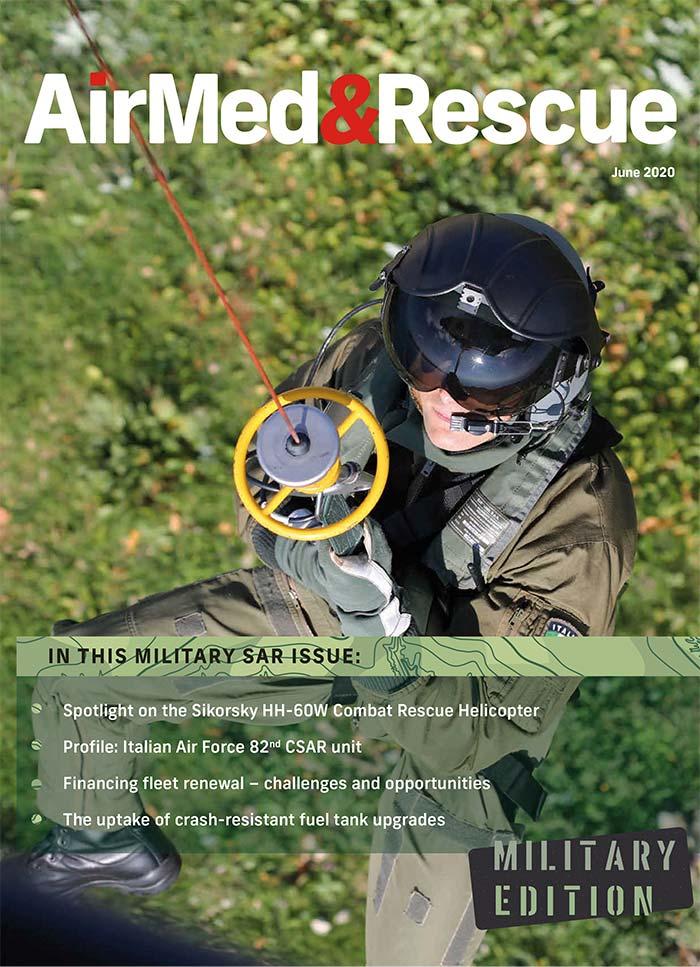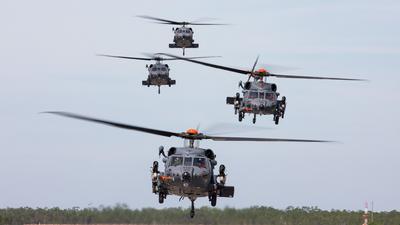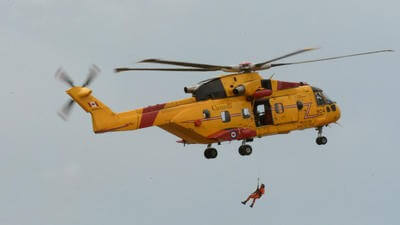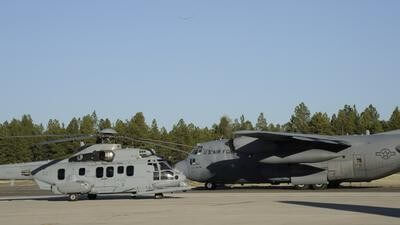Sikorsky HH-60W: The US Air Force's new combat rescue helicopter

AirMed&Rescue’s special correspondent Joetey Attariwala was one of a select few journalists invited to Sikorsky’s Development Flight Center in West Palm Beach, Florida, to cover the roll-out ceremony of the US Air Force (USAF) new Combat Rescue Helicopter – the Sikorsky HH-60W, affectionately known as the ‘Whiskey’. It was there that he had the opportunity to see the aircraft firsthand and interview program executives from Sikorsky and the USAF.
The USAF describes the mission of the Combat Rescue Helicopter (CRH) system as ‘one which provides Personnel Recovery (PR) forces with a vertical takeoff and landing aircraft that is quickly deployable and capable of main base and austere location operations for worldwide PR missions’. The CRH system activities may be required during any phase of a service / joint / coalition operation, across the full range of military operations, in any land or sea location, within the areas covered by the relevant defence planning scenarios. The aircraft will be self-supporting to the maximum extent practical; and an in-flight air refueling capability extends the combat mission range. The CRH system may conduct combat search and rescue (CSAR) airborne mission commander duties; and may also conduct other collateral missions inherent in their capabilities to conduct PR, such as non-conventional assisted recovery, national emergency operations, civil SAR, international aid, emergency aeromedical evacuation, disaster and humanitarian relief, counter drug activities, support for National Aeronautics and Space Administration flight operations, and insertion / extraction of combat forces.
The CSAR and PR mission is currently being conducted by the HH-60G Pave Hawk, which over the past 30 years has seen extensive use around the world, most notably in the Central Command Area of Responsibility. The Pave Hawk platform has seen modernization over its lifetime; however, system add-ons have increased maintenance and support requirements over the years. Speaking to this point was General James Holmes, Commander of Air Combat Command, who said: “Over 90 per cent of our legacy airplanes – the HH-60G fleet – have sustained combat damage or structural fatigue over the 30-plus years they have been in service, and the current availability rate is well below the requirement.” With statistics like that, it is no wonder the HH-60W is a highly anticipated platform for the USAF.
Introducing the Jolly Green II
The HH-60W is a highly modified variant of the battle-proven UH-60M Black Hawk, with the ‘Whiskey’ variant providing significant capability and reliability advancements over the HH-60G to better support the full range of combat rescue and other special missions. The HH-60W specification drives more capable defensive systems, vulnerability reduction, weapons, cyber security, environmental, expanded adverse weather sensor capabilities, and more comprehensive net-centric requirements.
The CRH contract consists of the original Engineering and Manufacturing Development (EMD) award, which was issued on 26 June 2014, and five additional System Demonstration and Test Article (SDTA) aircraft options, which were awarded in January 2017. In all, the CRH program of record calls for 113 helicopters, of which nine are EMD / SDTA aircraft and 104 will be production aircraft. In addition to purchasing the aircraft, the contract includes development and fielding of the aircrew and maintenance training systems along with product support.

Photo by Joetey Attariwala
Speaking at the Air Warfare Symposium in the US earlier this year was Secretary of the USAF Barbara Barrett, who used the event as a backdrop for the official naming ceremony of the HH-60W.
“The new Combat Rescue Helicopter, the HH-60 Whiskey, improves range and survivability for safer SAR operations everywhere, every time", said Barrett.
The new Combat Rescue Helicopter, the HH-60 Whiskey, improves range and survivability for safer SAR operations everywhere, every time
“The Air Force is naming our newest CSAR helicopter the Jolly Green II… Reviving the Jolly Green name honors our CSAR crews past and present. Those who operate this aircraft will embody the motto, ‘These Things We Do, That Others May Live’.”
Many aviation history buffs will immediately recognize that name, as it harks back to the 1960s, when HH-3E Jolly Green and HH-53 Super Jolly Green helicopters braved enemy fire to recover personnel during the Vietnam war. Not only is the HH-60W a notable platform from an AirMed&Rescue perspective, but it also does not take much effort to appreciate that it could be the Jolly Green II that charges out to save allied service persons during coalition operations. Also, it is acknowledged that there are six nations currently interested in the CRH – those that are known include the United Arab Emirates, Mexico, and the UK.
Ongoing development
Since achieving its first flight in May 2019, the CRH program now has a total of eight aircraft in flight. Six of the eight helicopters are engaged in expanded flight tests to support the path to Required Assets Available (RAA), while the other two aircraft are dedicated for training USAF pilots.
Speaking to AirMed&Rescue was John Biscaino, Senior Experimental Test Pilot with Sikorsky: “We’re building on the UH-60M and incorporating things that the HH-60G doesn’t have – Tactical Glideslope Approach, Mark on Top Approach, and Approach to Point are a few examples.” One notable area where the HH-60W retains 100-per-cent commonality with the UH-60M is the engine and dynamic systems, which aims to reduce total ownership cost over the entire life cycle.
Production of 10 Low Rate Initial Production (LRIP) Lot One aircraft has begun, and Sikorsky remains on track to meet contract delivery. The company was also awarded a second LRIP contract in February, which follows a string of significant program milestones in 2019. The new contract will have the company build 12 helicopters in Lot Two, which is valued at over US$500 million. Sikorsky is expected to submit a full-rate production (FRP) proposal at the end of 2020 for Lots Three to Five.
Testing 1, 2, 3
The HH-60W flight test program continues to operate under an Integrated Test Team (ITT) that comprises Sikorsky and Air Force personnel consisting of the 413th Flight Test Squadron, the 88th Test and Evaluation Squadron, and the Air Force Operational Test and Evaluation Center.
Testing continues at West Palm Beach in parallel with testing at Duke Field, which is also known as Eglin AFB Auxiliary Field #3. Eglin AFB was the site where a 413th Flight Test Squadron HH-60W went into the Joint Preflight Integration of Munitions and Electronic Systems (J-PRIMES) facility for defensive systems testing. According to the Air Force, this testing will characterize the performance of the helicopter’s systems prior to electronic warfare flight-testing. More recently, the Jolly Green II endured a month of harsh testing at Eglin’s McKinley Climatic Lab, which saw the aircraft subjected to temperatures ranging from 120°F to -60°F, as well as strong winds in heavy rainfall.
New capabilities
The CRH is capable of deployment day or night, in adverse weather, and in a variety of threat spectrums, from terrorist attacks to chemical, biological, radiological, and nuclear threats. The Air Force states that a single pilot must be able to fly and operate all electronic/sensor weapons systems, including countermeasures, leaving the second pilot to navigate, communicate, and manage mission execution.
There are numerous enhancements that make the HH-60W a formidable CRH. The aircraft incorporates improved structural design, which allows for shipboard compatibility, and a maximum gross weight of 22,500 pounds. According to Sikorsky, the aircraft meets all USAF requirements, with a combat radius of 195 nautical miles; hot and high altitude hover at 4,000 feet PA (pressure altitude) and 95°F; unprecedented net-centric capability; and best-in class survivability and lethality.
Key among survivability enhancements is improved floor and wall armor for the cabin and cockpit. The aircraft also has an advanced integrated defensive suite, which includes an APR-52 Digital Warning Receiver, the AVR-2B Laser Warning System, the AAR-57 missile and hostile fire warning system, and six integrated chaff and flare dispensers.

Photo by Joetey Attariwala
Speaking to AirMed&Rescue was Greg Hames, Sikorsky’s CRH Program Director. “One of the key aspects of this aircraft is to survive in the modern battlefield.
One of the key aspects of this aircraft is to survive in the modern battlefield.
"Downed personnel are usually not in close proximity to medical facilities, so you have to go out and get them,” he said. “Part of the structural differences in this aircraft over the G-model is we have 660 gallons of fuel inside the fuselage. It’s no longer externally supported, nor is it part of what’s called the tactical bulk fuel delivery system, which are big rubber bladders. We’ve been able to incorporate it inside the aircraft structure, which allows us to double the capacity so we have exceptional range capability. We’ve also developed an adaptable gun mount system capable of integrating multiple gun systems such as the GAU-2, GAU-18 and the GAU-21.”
Another key aspect to the HH-60W is its versatile cabin, which is optimized for CSAR missions. Multiple configurations are available depending on the mission at hand; this includes litter stations and stowable pararescuemen seating into the cabin ceiling to maximize cabin space.
Current technological enhancements have outpaced several baseline requirements for the CRH, and that has required changes to address survivable CSAR tactical operations against the latest enemy threat weapons development and to alleviate obsolescence issues. The first increments include outdated system removal, and the addition of an EO / IR symbology pilotage overlay with Integrated Cueing Environment restricted visibility approach landing guidance symbology.
An improved IR jamming system is being integrated for the highest concern modern threats codified in a Joint Urgent Operational Need Statement and supplemental threat list. One can safely assume that this will take the form of a Distributed Aperture Infrared Countermeasure system, the likes of which has recently been fielded on the Pave Hawk.
Follow-on increments will include: degraded visibility environment sensor and cueing suite, GPS anti-jam, video data link, Blue Forces Tracking 2 satellite-based data link and the integration of electronic flight bags into the cockpit avionics. The result will be a more robust, multi-domain operations capable platform that will allow the Air Force to rescue airmen / women in all environments.

Photo by Joetey Attariwala
Tactical mission kit
Lockheed Martin’s Owego, New York, facility is developing the HH-60W Tactical Mission Kit (TMK) which will integrate the aircraft’s sensors, radar, and survivability-enhancing defensive / communication systems that add blended, geo-registered situational awareness displays into the aircraft. The aircraft’s cockpit has four multi-function color displays, while the cabin is fitted with three displays.
“The TMK is another example of our commitment to open systems that reduce pilot and crew mission management workload while increasing situational awareness in high task load environments,” said Mission Systems Program Director Scott Breen.
Stricter environmental requirements necessitate effective, filtered air handling to keep those tactical mission systems cool in the hottest climates; while greater electrical demands required upgrades to the main and Auxiliary Power Unit (APU) generators to provide more redundant power supply.
Additionally, the HH-60W features full integration of three different weapons systems. It adds mounts, ammunition handling provisions and electrical control for fixed forward and crew-served weapons for two different .50 caliber weapons and one 7.62mm weapon.
“The TMK allows pilots the freedom to fly with a lot of situational awareness, and it also allows the SMAs [Special Mission Aviator] in the back to be able to see all of the data necessary for them to perform their missions, whether that’s putting down suppressive fire, or, more importantly, using the rescue hoist to save people’s lives,” said Hames.

Photo by Joetey Attariwala
Training
To ensure mission readiness, Lockheed Martin Training, Logistics & Sustainment will deliver a custom-tailored training system consisting of flight simulators, procedural and maintenance trainers and accompanying courseware.
Sean Cattanach, Senior Program Manager for Lockheed Martin Training and Logistics, spoke about HH-60W pilot and aircrew training: “We’re delivering a single HH-60W full-motion flight simulator to Kirtland Air Force Base, and they currently have options for two more. I should add that those full-motion flight sims are an entire crew training simulator, so it has the cockpit and the special mission aviators, with their own visual systems just behind the cockpit, as in the real aircraft. It is a very large simulator, which will allow the Air Force to do a lot of things, primarily crew co-ordination,” said Cattanach. “If you take that same basic layout and put it on a fixed-base, those are the simulators going to each main operating base.”
This year, Lockheed Martin will train 200 USAF maintenance aircrew students at its West Palm Beach facility in Florida, utilizing training systems and three newly built HH-60W aircraft. This will provide flight and maintenance training to initial cadre and units allowing the USAF to simultaneously field and employ the added capabilities of the HH-60W aircraft.
Speaking to AirMed&Rescue just after his first flight in a HH-60W was Dr Will Roper, Assistant Secretary of the Air Force for Acquisition, Technology and Logistics. He said: “I’m extremely proud of the Government and Sikorsky team who really worked hard to get to Milestone C. I think the future is bright for this program; it was fun flying in it and I learned a lot about it, especially how stable it was when it was flying itself – that was amazing! I imagine our operators who haven’t had a new Combat Rescue Helicopter in 30 years will be really happy with it.”
Roper added: “If you want to know something that I think is very likely to happen, seeing where a lot of countries are on their helicopters of similar scale, I would not be surprised if we start seeing a lot of foreign military sales requests
I would not be surprised if we start seeing a lot of foreign military sales requests
, so I think that’s great for Sikorsky and it’s great for us. One of our great strengths is that we equip so many allies and partners, and train together and we have interoperability, so I expect that’s going to be the next evolution; and then depending on what happens in future, Air Combat Command may revisit the number and it may decide to modernize. We have to keep options open – it’s too complicated a threat environment to say here’s our 30-year plan – I doubt looking ahead more than five years is of use anymore.”

June 2020
Issue
In this Military Edition:
- Feature: HH-60 Combat Rescue Helicopter
- Military SAR, a look ahead
- Provider Profile – Italian Air Force
- Crash-resistant fuel tank uptake
- Lease or buy - renewing air medical fleets
- First-pass success in pre-hospital intubation
- Case Study: PIU repatriation of fully ventilated patient
Dr Joetey Attariwala
Dr Attariwala trained as a medical doctor and has established himself as a highly regarded journalist who contributes to various aerospace, defense, training and simulation, and law enforcement publications around the world. He is a regular contributor to AirMed&Rescue magazine.




